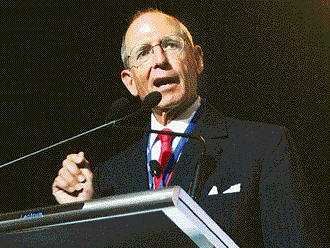News in brief

L-3 CEO Frank Lanza dies ... Rossotti: Tear down barriers to change ... Cole urges holistic security, and more ...

The Carlyle Group's Charles Rossotti says the biggest obstacle to change is convincing people that it is possible and getting them to buy into it.
Rick Steele
"The opinion many people had was that IRS couldn't change and was frozen," Rossotti said in describing the mind-set when he took over the agency in 1997. "That mental roadblock has been broken."
Co-founder and former CEO of American Management Systems Inc. (now part of CGI-AMS, Fairfax, Va.), Rossotti is the author of "Many Unhappy Returns: One Man's Quest To Turn Around The Most Unpopular Organization In America," which chronicles how he led IRS through a major transformation under the Clinton administration.
Changing the technology is relatively simple, Rossotti said. It's changing the perceptions of the people who will use the new technology that can be the tricky part.
Delivering a keynote speech at the midyear conference of the National Association of State Chief Information Officers, Rossotti shared tips for guiding an organization through a transformation project.
A problem plaguing many organizations looking for large transformation is the lack of alignment or even conflicting goals of many of the parties involved, Rossotti said. State technology leaders should get actively involved in the process, as should agency heads and their staffs.
But the private sector must be involved in the discussion as well, and the three groups often have divergent goals, he said.
At IRS, one crucial way Rossotti facilitated change was by getting people from all levels of the agency, as well as from outside the organization, to give their input on the agency's problems. He did that through a series of steering committees that drew active participation, and helped him learn the depth and breadth of the problems he had inherited.
"It's not fun," Rossotti said. "but they can be made into a vehicle to help overcome critical, cross-organizational issues."
? Ethan Butterfield
L-3 CEO Frank Lanza dies
Frank Lanza, chairman and CEO of L-3 Communications Inc., died June 6, leaving a legacy that includes building two large successful government defense companies. He was 74.
Lanza, who had visited with his doctors earlier June 6, was recovering from esophagus surgery two months ago, according to Reuters. Doctors had removed acid-reflux-related scarring that prevented him from swallowing food.
Robert Millard, lead director of the L-3 Communications board of directors, said in a statement June 7 that Lanza's death was "sudden and unexpected. We are all shocked and saddened by the passing."
"There is no question that Frank Lanza has been one of the most visionary business leaders in the defense industry," Millard said.
Before founding L-3 Communications, Lanza was president and chief operating officer of Loral Corp. In April 1996, Lockheed Martin Corp. acquired Loral. Lanza became executive vice president of Lockheed Martin and was appointed to the company's executive council and board of directors.
He formed L-3 in 1997 from 10 businesses that Lockheed Martin divested. He rapidly grew L-3 through acquisitions and internal growth. His largest acquisition came last year when the company acquired Titan Corp.
L-3 ranks No. 7 on Washington Technology's 2006 Top 100 list of top federal prime contractors. The company has no clear succession plan, analysts told Reuters.
Cole urges holistic security
IT security professionals must move from reacting to threats to proactive protection, said a Lockheed Martin Corp. scientist at the eighth annual Techno Security conference in Myrtle Beach, S.C. this month.
Organizations must first identify their core intellectual property; then they can take the steps needed to guard it, said Eric Cole, a senior scientist with Lockheed Martin's IT group.
"If you don't know what you're trying to secure, how can you [know] you have secured it?" he said.
VoIP R Us, like it or not
If you believe vendors at this month's GlobalComm trade show in Chicago, in the not-too-distant future, IP will be the dominant transport mechanism for voice.
For the first time, the number of VoIP ports sold last year outpaced traditional, time-division multiplexing phone ports, although most of those are not yet in production.
As telephone equipment in use reaches the end of its supported life, carriers and enterprises will be forced to move voice traffic to IP, vendors said.
Labor issues card RFP
The Labor Department last week issued a solicitation seeking a vendor to provide Personal Identity Verification cards to agency employees and contractors.
The solicitation comes as agencies scramble to meet the Homeland Security Presidential Directive-12 deadline to begin issuing PIV cards by Oct. 27. The agency noted that the mandate is unfunded, and said it will take a phased approach to meeting the requirements.
MIMO WiFi, bigger bandwidth
A new WiFi technology, still in development, could offer new oomph to municipal wireless networks.
Wavion Inc.'s multiple-input, multiple-output (MIMO) technology can "provide 54 Mbps well beyond where conventional access points can even have a signal," a company official said.
Conventional WiFi access points use two receiving antennas and one transmitting antenna. Each of Wavion's metro-scale access points uses six radios and antennas using complex signal processing to shape the transmission channels for maximum bandwidth and coverage.
Mich. poised for partnerships
Michigan's efforts to consolidate IT resources of 19 state agencies into a single department with 1,700 employees has paid off, and it is now gearing up for the next steps.
The state's new challenge is to promote public-private, cross-boundary initiatives; request broader and more innovative proposals for solutions from the private sector; and be open to new business models, said Teresa Takai, director of Michigan's IT Department.
Satellite links go broadband
Inmarsat PLC has launched a new satellite network service offering bigger pipes through smaller terminals that it hopes will be a hit with the military and first responders.
The satellite service provider is touting its Broadband Global Area Network, which offers speeds of up to 492 Kbps for data and switched-voice channels.
The company hopes the service will be popular with first responders during the hurricane season, because it can provide high-speed voice and data communications independent of terrestrial infrastructure, which could be downed by severe weather.
NARA: Improve records tactic
The federal government needs to apply a more integrated approach to declassifying records, said a new report from the National Archives and Records Administration.
Multiple, inefficient and sometimes ineffective independent agency reviews of the same material must be stopped, the report said. The number of documents being classified dropped to 14.2 million in fiscal 2005, a decrease from 15.6 million the year before.
Recovery plan rises at Sun
As part of an effort to make its struggling enterprise computing business regain profitability, Sun Microsystems Inc. will eliminate 4,000 to 5,000 jobs over the next six months, company officials said.
The job reductions would cut 11 percent to 13 percent of Sun's workforce of roughly 37,500. The cuts will be made worldwide, and it has not yet been determined whether they will specifically affect the company's U.S. federal division, said a Sun spokeswoman.
NASCIO's partnership primer
Study the issues. Be patient. Don't skirt the proper channels.
These are a few of the tips that companies doing business with state governments should heed, according to the National Association of State Chief Information Officers' new brief on how to build effective public private-partnerships for IT projects.
The brief, a joint effort of NASCIO leaders and the group's private sector arm, the Corporate Leadership Council, lays out the challenges behind building partnerships, including a review of partnership models.
GSA awaits RFP feedback
The General Services Administration issued the second set of draft requests for proposals for its 10-year, $65 billion Alliant procurement program to let federal agencies buy a wide range of IT services.
Industry has until June 30 to submit comments for the draft RFPs, which reflect changes in the strategy for the $50 billion Alliant full and open governmentwide acquisition vehicle and the $15 billion Alliant small-business set-aside contract.
Network planned for Traveler
A centralized information network will aggregate, store and distribute data to all entities participating in Registered Traveler, according to the Transportation Security Administration's new business model for the program.
Contractors would include enrollment providers, which would collect fees and biographic information and issue ID cards to participating travelers, and verification providers, which would confirm the traveler's identity at the airport.
Travelers provide biometrics and submit to an advanced screening, and in exchange, Registered Traveler speeds them through airport processing.
RFID stance draws fire
An internal advisory group in the Homeland Security Department is making incorrect generalizations about radio frequency identification technology and has offered no scientific evidence to back up its claims, an IT trade group charged.
The American Electronics Association objected to DHS' Emerging Applications and Technology Subcommittee's draft report that said RFID might be appropriate for human identification in limited situations, such as for tracking miners and firefighters.
Davis blocks mega-deal
Rep. Tom Davis (R-Va.) has called on the Office of Electronic Government to intervene in the Treasury Department's plans to award its own contentious billion-dollar communications contract instead of using the General Services Administration's Networx telecommunications program.
Davis wrote Karen Evans, administrator of e-government and IT in the Office of Management and Budget, asking her to intercede and step up her support for his efforts to stop Treasury from awarding the 10-year, $1 billion Treasury Communications Enterprise contract.
WiMax wait may be over
The United States is an insignificant portion of an already small market for WiMax broadband wireless technology, said industry spokesmen at this month's meeting of the WiMax Forum.
The expected emergence later this year of equipment operating in U.S. frequency bands could help spark demand in this country, they said.
In January, six months later than expected, the Forum certified the first interoperable products for the 802.16 Air Interface Standard, but the certification process is expected to boost carrier confidence in the technology.
NEXT STORY: 'Tis the season for change, change, change

